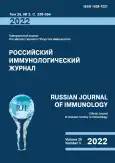Immune response against DNA- and mRNA vaccines encoding artificial influenza virus immunogens
- 作者: Starostina E.V.1, Sharabrin S.V.1, Rudometov A.P.1, Litvinova V.R.1, Borgoyakova M.B.1, Bazhan S.I.1, Ilyichev A.A.1, Karpenko L.I.1
-
隶属关系:
- State Research Centre of Virology and Biotechnology “Vector”
- 期: 卷 25, 编号 3 (2022)
- 页面: 321-326
- 栏目: SHORT COMMUNICATIONS
- URL: https://bakhtiniada.ru/1028-7221/article/view/120209
- DOI: https://doi.org/10.46235/1028-7221-1103-IRA
- ID: 120209
如何引用文章
全文:
详细
Constant antigenic drift of circulating influenza viruses leads to inefficiency of seasonal influenza vaccines, thus requiring annual re-design of these vaccines. Therefore, the development of a universal influenza vaccine is of particular relevance. A promising line of research in this area is to design the immunogens consisting of conserved protein fragments from different influenza viral strains. The aim of this work was to assess immunogenicity of DNA vaccines and mRNA vaccines encoding artificial antigens consisting of conserved hemagglutinin stem fragments and conserved M2 protein. We have obtained DNA vaccine constructs encoding artificial immunogens AgH1, AgH3, and AgM2, which contained conserved fragments of the hemagglutinin stalk from the two subtypes of influenza A – H1N1 and H3N2, and conserved M2 protein. These DNA vaccines were used as templates for the synthesis of mRNA vaccines. To assess immunogenicity of the obtained constructs, BALB/c mice were immunized with DNA and mRNA vaccines by i/m administration. Assessment of the humoral immune response was carried out by ELISA, using influenza viruses A/Aichi/2/68(H3N2), A/California/07/2009 as antigens and the ULTRIX vaccine containing purified antigens of H1N1 and H3N2 influenza viruses. T cell immune response was assessed using two methods: intracellular cytokine staining (ICS) and ELISpot. ICS was performed to determine CD8+ and CD4+T-lymphocytes producing IFNγ. ELISpot was carried out using the mouse IFNγ ELISpot kit (BD). A peptide mixture which included composition of the target antigens, was used for cell stimulation. The results showed that the designed DNA vaccine constructs induce virus-specific humoral and cellular responses in immunized BALB/c mice. Intramuscular administration of the naked mRNA vaccine constructs induced a weak humoral immune response, thus suggesting a need for further work to improve the delivery approaches.
作者简介
E. Starostina
State Research Centre of Virology and Biotechnology “Vector”
编辑信件的主要联系方式.
Email: starostina_ev@vector.nsc.ru
PhD (Bilogy), Research Associate, Department of Bioengineering
俄罗斯联邦, Koltsovo, Novosibirsk RegionS. Sharabrin
State Research Centre of Virology and Biotechnology “Vector”
Email: starostina_ev@vector.nsc.ru
Junior Research Associate, Department of Bioengineering
俄罗斯联邦, Koltsovo, Novosibirsk RegionA. Rudometov
State Research Centre of Virology and Biotechnology “Vector”
Email: starostina_ev@vector.nsc.ru
PhD (Bilogy), Senior Research Associate, Department of Bioengineering
俄罗斯联邦, Koltsovo, Novosibirsk RegionV. Litvinova
State Research Centre of Virology and Biotechnology “Vector”
Email: starostina_ev@vector.nsc.ru
Junior Research Associate, Department of Bioengineering
俄罗斯联邦, Koltsovo, Novosibirsk RegionM. Borgoyakova
State Research Centre of Virology and Biotechnology “Vector”
Email: starostina_ev@vector.nsc.ru
Junior Research Associate, Department of Bioengineering
俄罗斯联邦, Koltsovo, Novosibirsk RegionS. Bazhan
State Research Centre of Virology and Biotechnology “Vector”
Email: starostina_ev@vector.nsc.ru
PhD, MD (Bilogy), Leading Research Associate, Department of Bioengineering
俄罗斯联邦, Koltsovo, Novosibirsk RegionA. Ilyichev
State Research Centre of Virology and Biotechnology “Vector”
Email: starostina_ev@vector.nsc.ru
PhD, MD (Bilogy), Professor, Head, Department of Bioengineering
俄罗斯联邦, Koltsovo, Novosibirsk RegionL. Karpenko
State Research Centre of Virology and Biotechnology “Vector”
Email: starostina_ev@vector.nsc.ru
PhD, MD (Bilogy), Leading Research Associate, Department of Bioengineering
俄罗斯联邦, Koltsovo, Novosibirsk Region参考
- Bazhan S.I., Antonets D.V., Starostina E.V., Ilyicheva T.N., Kaplina O.N., Marchenko V.Y., Durymanov A.G., Oreshkova S.F., Karpenko L.I. Immunogenicity and protective efficacy of influenza a DNA vaccines encoding artificial antigens based on conservative hemagglutinin stem region and M2 protein in mice. Vaccines (Basel), 2020, Vol. 9, no. 8 (3), pp. 448-465.
- Bazhan S.I., Antonets D.V., Starostina E.V., Ilyicheva T.N., Kaplina O.N., Marchenko V.Y., Volkova O.Y., Bakulina A.Y., Karpenko L.I. In silico design of influenza a virus artificial epitope-based T-cell antigens and the evaluation of their immunogenicity in mice. J. Biomol. Struct. Dyn., 2022, Vol. 40, no. 7, pp. 3196-3212.
- Ilyichev A.A., Orlova L.A., Sharabrin S.V., Karpenko L.I. mRNA technology as one of the promising platforms for the SARS-CoV-2 vaccine development. Vavilov Journal of Genetics and Breeding, 2020, Vol. 24, no. 7, pp. 802-807.
- Karpenko L.I., Rudometov A.P., Sharabrin S.V., Shcherbakov D.N., Borgoyakova M.B., Bazhan S.I., Volosnikova E.A., Rudometova N.B., Orlova L.A., Pyshnaya I.A., Zaitsev B.N., Volkova N.V., Azaev, M.S., Zaykovskaya A.V., Pyankov O.V., Ilyichev A.A. Delivery of mRNA vaccine against SARS-CoV-2 using a polyglucin:spermidine conjugate. Vaccines, 2021, Vol. 9, no. 2, 76. doi: 10.3390/vaccines9020076.
- Kumar A., Meldgaard T.S., Bertholet S. Novel platforms for the development of a universal influenza vaccine. Front. Immunol., 2018, Vol. 9, 600. doi: 10.3389/fimmu.2018.00600.
- Liu M.A. A comparison of plasmid DNA and mRNA as vaccine technologies. Vaccines, 2019, Vol. 7, no. 2, 37. doi: 10.3390/vaccines702 0037.
- Tsilibary E.P., Charonis S.A., Georgopoulos A.P. Vaccines for Influenza. Vaccines (Basel), 2021, Vol. 9, no. 1, 47. doi: 10.3390/vaccines9010047.
- Wang W.L., Li R.Q., Deng Y., Lu N., Chen H., Meng X., Wang W., Wang X.P., Yan K.X., Qi X.R., Zhang X., Xin W., Lu Z., Li X., Bian T., Gao Y., Tan W., Ruan L. Protective efficacy of the conserved NP, PB1, and M1 proteins as immunogens in DNA- and vaccinia virus-based universal influenza A virus vaccines in mice. Clin. Vaccine Immunol., 2015, Vol. 22, pp. 618-630.
- Wei C.J., Crank M.C., Shiver J., Graham B.S., Mascola J.R., Nabel G.J. Next-generation influenza vaccines: opportunities and challenges. Nat. Rev. Drug. Discov., 2020, Vol. 19, pp. 239-252.
- Wei C.J., Crank M.C., Shiver J. Next-generation influenza vaccines: opportunities and challenges. Nat. Rev. Drug. Discov., 2020, Vol. 19, no. 4, pp. 239-252.
- Zhang C., Maruggi G., Shan H., Li J. Advances in mRNA vaccines for infectious diseases. Front. Immunol., 2019, Vol. 10, 594. doi: 10.3389/fimmu.2019.00594.
补充文件







